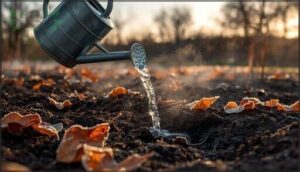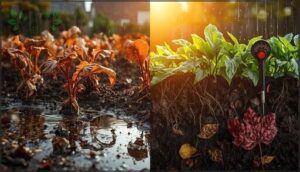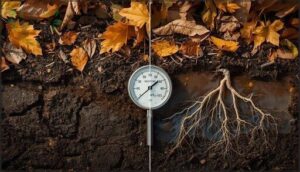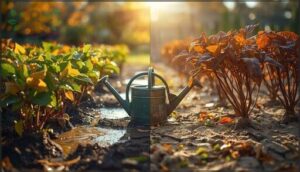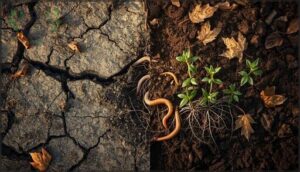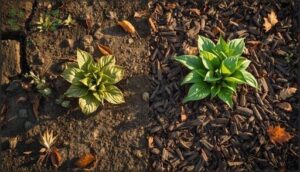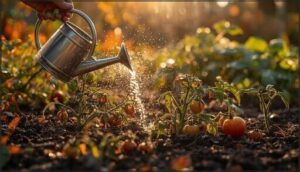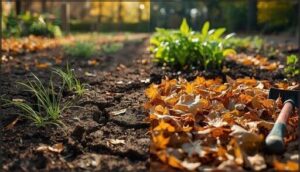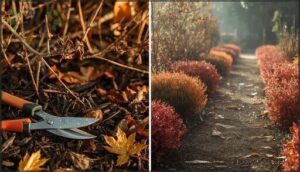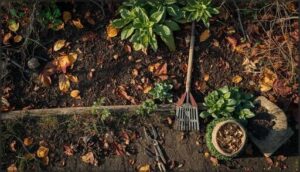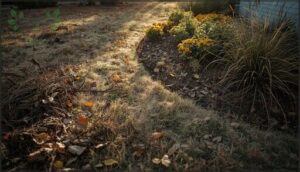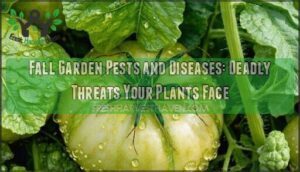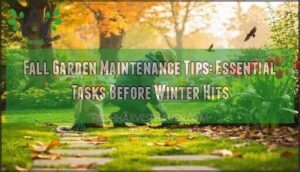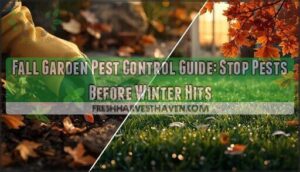This site is supported by our readers. We may earn a commission, at no cost to you, if you purchase through links.
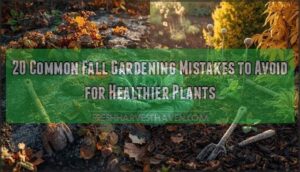
Many gardeners prune at the wrong time or remove perennial growth that wildlife depends on, while others skip essential cleanup that invites pests and disease to overwinter. Poor soil preparation, inadequate mulching, and forgetting to fertilize lawns before dormancy set plants up for weak spring recovery.
The good news? Each mistake has a straightforward fix that protects your garden investment.
Table Of Contents
- Key Takeaways
- Watering and Soil Mistakes in Fall
- Failing to Water Before First Frost
- Not Adjusting Watering to Weather
- Ignoring Soil Moisture Levels
- Overwatering or Underwatering Plants
- Using Poor Quality or Unamended Soil
- Failing to Mulch for Moisture Retention
- Watering at The Wrong Time of Day
- Not Watering Trees and Shrubs Enough
- Leaving Soil Bare and Exposed
- Common Plant Care and Pruning Errors
- Overlooking Fall Garden Cleanup and Maintenance
- Planning and Preparation Shortcomings
- Neglecting Lawn and Perennial Care
- Frequently Asked Questions (FAQs)
- What not to plant in the fall?
- What is the gardening 3 year rule?
- What gardening should be done in the fall?
- What is the rule of 3 in gardening?
- Can I plant trees in fall?
- When should I fertilize fall gardens?
- How do I prepare roses for winter?
- Should I water plants before frost?
- Can I move perennials in autumn?
- Should I fertilize my lawn in fall?
- Conclusion
Key Takeaways
- Deep watering before the first frost and proper fall irrigation protect root systems from winter damage and set plants up for healthier spring recovery. – Skipping fall cleanup—leaving diseased plants, debris, and dirty tools—invites pests and diseases to overwinter, creating bigger problems next season. – Poor soil preparation, inadequate mulching, and forgetting to fertilize lawns before dormancy weaken plants and reduce their ability to bounce back in spring. – Timing mistakes like delayed planting, pruning at the wrong time, or cutting back perennials too early can cost you blooms, wildlife habitat, and plant vigor.
Watering and Soil Mistakes in Fall
Taking care of your plants in fall means getting watering and soil treatment just right.
A few common mistakes can trip you up when you’re prepping for cooler weather.
Failing to Water Before First Frost
If you let your garden dry out before that first real freeze, your plants may have a much tougher time bouncing back in spring. Roots need hydration for late-season growth and insulation from frost damage. Consistent watering in the fall garden helps plants thrive next year.
Without consistent watering before the first freeze, roots lose vital hydration needed for winter survival and strong spring growth
Here’s how to keep your garden healthy going into winter:
- Watering deeply before frost
- Checking soil moisture regularly
- Prioritizing root hydration
- Supporting resilient spring growth
Not Adjusting Watering to Weather
Even when you’ve mastered timing your last watering before the frost, watching how rainfall and changing temperatures affect your garden can make all the difference through autumn. Adaptive irrigation—adjusting for regional variations or surprise storms—saves your plants from stress and rot. Use a soil moisture meter to guide fall watering decisions.
| Weather | Impact on Watering | What To Do |
|---|---|---|
| Cool/Rainy | Less needed | Shorten routines |
| Mild/Dry | More needed | Increase frequency |
| Frosty Snap | Protect roots | Deep, final soak |
Ignoring Soil Moisture Levels
It’s easy to miss just how dry or soggy your soil really is until your plants start showing signs of trouble. Checking with a soil moisture meter takes the guesswork out of moisture monitoring tools and keeps you ahead of problems.
Different soil textures impact fall watering depth and consistent soil hydration, preventing root health issues often mistaken for common fall gardening mistakes.
Overwatering or Underwatering Plants
Every gardener knows the struggle—just when you think you’ve figured out how much water your soil holds, you end up giving your plants a little too much or not quite enough. Overwatering or underwatering plants in fall can harm root health quickly.
Keep an eye on how your plants look, think about what the weather’s been doing lately, and tweak how often you water based on how well your soil drains—it’ll help you sidestep the usual fall mistakes while getting everything ready for winter.
Using Poor Quality or Unamended Soil
When your fall soil goes unamended or lacks key nutrients, plants quietly struggle through winter. Poor soil health drags down spring yields, while erosion and compaction cut root vigor.
Expect these consequences:
- Soil Nutrient Deficiency halts strong growth. – Spring Yield Impact leaves you disappointed. – Erosion and Compaction threaten root spread. – Microbial Life Decline weakens plant resilience.
To assure accurate results, regard the importance of effective nutrient management when sampling.
Failing to Mulch for Moisture Retention
When you skip a layer of mulch, even the shortest dry spell can quickly turn your garden’s soil bone-dry and unforgiving. Mulch types make all the difference—retaining precious moisture, stabilizing soil temperature, and suppressing weeds.
Forgetting this step leads to greater moisture loss, soil erosion, and missed chances to shield your fall garden, risking your soil health as you prepare for winter.
Watering at The Wrong Time of Day
Even the best intentions can backfire if you reach for the hose at the hottest part of the day. Midday watering often evaporates before plants have a chance to drink, leaving roots thirsty and soil moisture uneven.
That mistake raises drought vulnerability and root damage. Watering early or late leads to better water absorption—an easy fix for avoiding fall gardening mistakes and protecting your fall garden.
Not Watering Trees and Shrubs Enough
Think your big trees and sturdy shrubs don’t get thirsty?—those roots are quietly waiting for a deep drink before winter hits. Skipping fall watering can lead to tree water stress, poor drought tolerance, and root damage.
Healthy soil moisture now boosts water absorption and resilience. Prioritizing deep, slow watering is key to preparing your garden for winter and avoiding fall gardening mistakes.
Leaving Soil Bare and Exposed
Bare soil invites trouble—weeds, erosion, and moisture loss all chip away at your garden when it needs protection most.
Here’s what works in fall:
Layer leaf mulch to lock in moisture and insulate roots. Plant cover crops to shield bare patches and enrich the soil. Leave plant residue in place to slow erosion.
When prepping your garden for winter, these steps matter more than fancy techniques.
Common Plant Care and Pruning Errors
Fall plant care isn’t just about water and fertilizer. Here are the pruning and maintenance mistakes that trip up most gardeners when temperatures drop.
Caring for plants in fall goes beyond basic watering and feeding. Let’s look at the most common mistakes folks make with pruning and plant care as the season changes.
Pruning The Wrong Plants or at Wrong Time
Pruning Timing isn’t just a calendar detail—it shapes the life and health of your garden. If you cut back the wrong plants now, you risk Seasonal Damage: lost blooms, weak growth, and increased disease.
Always match your Pruning Tools to the job and remember, smart fall garden preparation means knowing which perennials need rest, not shears. Understanding the importance of fall perennial care is essential for maintaining a healthy garden ecosystem.
Removing Perennial Growth That Benefits Wildlife
When you cut back perennials or clear away every bit of plant debris during fall yard cleanup, you’re erasing essential wildlife habitat.
Leaving some perennial plants and seed heads standing assists Pollinator Conservation and Biodiversity Assistance. Native Plantings left intact shelter beneficial insects and birds—an anchor for garden wildlife.
This small gesture boosts your garden’s ecosystem services all winter long.
Delayed Planting or Harvesting
Garden timing affects everything from planting to harvest. Leave seed heads standing to help wildlife through winter, but don’t miss your window for fall crops—late season sowing means racing against frost, bulb planting deadlines, and the seasonal shift.
Just as leaving seed heads standing aids wildlife through the winter, paying attention to your garden’s timing makes all the difference regarding planting and harvesting.
Waiting too long on Late Season Sowing or Fall Crop Timing means crops miss their window for Plant Maturation—especially as first frost approaches, bulbs need planting, and harvest scheduling becomes a race against seasonal transitions and fallen leaves.
Inadequate Spacing Between Plants
When your plants are squeezed too close together, they end up fighting for room, water, and sunlight—kind of like neighbors who don’t get on. Plant Crowding reduces Air Circulation and encourages Root Competition, leading to Growth Restrictions and more Shade Effects than you bargained for. Good plant spacing grows healthier gardens and makes garden planning and plant selection much easier.
- Less plant disease due to improved air movement
- Roots expand, not tangle, so stress drops
- Sunlight reaches more leaves, boosting bloom and fruit
- Harvests are simpler, faster, and more rewarding
- Prevents shade effects that make plants spindly and weak
Neglecting to Protect Young or Vulnerable Plants
After making sure your garden isn’t crowded, it’s just as important to watch out for the little guys who can’t fend for themselves when the cold, pests, or hungry critters show up. Plant Shielding and Frost Protection matter most for tender or newly planted varieties. Use soil insulation or winter covering methods to keep vulnerable species safe.
| Tip | Benefit |
|---|---|
| Frost Cloths & Domes | Protects new seedlings |
| Mulch for Soil Insulation | Keeps roots from freezing |
Disposing of Leaves Instead of Composting
While it might seem easier to bag up those fallen leaves and set them by the curb, you could be tossing away some of the best free fertilizer your garden will ever see. Leaf composting and fall mulching turn yard waste into organic matter that feeds your soil.
- Builds rich, crumbly compost
- Reduces plant debris and yard waste
- Boosts soil enrichment and moisture
Overlooking Fall Garden Cleanup and Maintenance
Keeping up with fall garden cleanup and maintenance is key if you want your plants to thrive.
A few tasks deserve attention before the cold really sets in.
Here’s what you don’t want to overlook as the season winds down.
Not Removing Dead or Diseased Plants
Think of dead or diseased plants as an open invitation for trouble. If you skip fall sanitation and allow plant debris to linger, you set the stage for next year’s pest outbreaks and plant diseases. Removing deadheads and infected material isn’t just tidying—it’s key for Disease Prevention, solid Pest Control, and long-term Soil Health.
| Problem | What Happens Next | Best Practice |
|---|---|---|
| Dead plants remain | Pests overwinter | Remove debris |
| Diseased plants stay | Diseases reappear | Dispose, don’t compost |
| Debris left | Soil declines | Clean for Soil Health |
Ignoring Weed Control and Fall Weeding
If you let weeds fly under the radar in fall, they’ll be back in full force before you know it—crowding out your hard work come spring. Cool-season weeds thrive in leftover plant debris and fallen leaves, setting winter weed seeds. Stay ahead with fall weed ID, preventative weeding, and smart herbicide use.
Imagine:
- Patches of clover sneaking between perennials
- Hidden seedlings stretching beneath mulch
- Dandelions anchoring themselves for spring
- Last year’s plant debris hosting fresh invaders
Failure to Clean and Disinfect Tools
A dirty pair of pruning shears can spread more trouble in your garden than any passing bug. Without regular cleaning and sharpening, tools transfer disease from plant to plant, invite pests, and cause wounds that don’t heal well.
Prioritize cleaning gardening tools and disinfection best practices—wipe off sap, sterilize blades, and use rust prevention methods. These small habits solve big, common gardening problems.
Storing Tools Improperly Over Winter
It’s remarkable how quickly a season’s hard work can go to waste if your garden tools spend the winter rusting away in the shed. Rust prevention starts with proper cleaning, sharpening blades, and wiping down garden machinery before storage.
Secure storage means tools won’t disappear come spring. An annual inventory check might save you a last-minute, expensive trip to the hardware store.
Leaving Plant Debris That Harbors Pests
Piles of old stems and faded leaves aren’t just clutter—they’re a five-star winter resort for garden pests looking to move in for the season.
To keep your garden healthy and pest-free, fall debris removal is key.
Piles of old stems and faded leaves aren’t just clutter—they’re a five-star winter resort for garden pests looking to move in for the season. For the best pest control and garden sanitation, tackle fall debris removal:
- Clear diseased plants to halt disease spread. 2. Remove debris that harbors pests. 3. Disturb hiding spots for pest overwintering. 4. Leave stems for beneficial insects.
Planning and Preparation Shortcomings
A little prep work in fall pays off when spring rolls around. Most gardeners skip these steps without realizing it.
Planning ahead in the fall can make a big difference in how your garden performs next season. Here are some common ways that preparation often gets overlooked.
Not Planning for Spring Gardens
Neglecting to plan for your spring garden in the fall leaves you scrambling later, often missing the best bulb planting windows and seed starting schedules.
A thoughtful approach now—mapping out succession planting plans, refining your garden layout design, and doing a tool inventory check—ensures you’re set for efficient spring crop rotation, healthy perennial beds, and productive bulb planting when the season turns.
Poor Garden Location Selection
Once you’ve mapped your spring planting plans, it’s easy to forget that where you put your garden beds can make or break your season. Overlooking sunlight exposure, soil drainage, or space constraints often leads to stunted growth.
Take time to study microclimates, air circulation, and ease of access—these factors influence your soil health and overall success when choosing a garden location.
Failing to Assess Yard and Available Space
Looking past sunlight and drainage is easy, but forgetting to measure how much room you really have can tangle up even the best garden plans. Space assessment is key—think about where you’ll walk, how far roots will spread, and if your garden location leaves space for changes down the road.
Consider:
- Pathways for tools or wheelbarrows
- Sunlight exposure analysis
- Soil type awareness
Not Considering Specific Plant Needs
Once you know where each plant belongs, the next step is understanding what makes it tick. Plant-specific care means more than reading a tag—you’re looking at how much water it wants, what kind of light it craves, which soil it prefers, and when it needs feeding.
After you’ve figured out where everything should go, the real trick is learning what each plant on your wish list actually needs to thrive. Plant-specific care goes beyond sticking a label in the ground—think individual watering needs, light requirements, soil preferences, and fertilization schedules.
The right approach now can prevent nutrient deficiency, tough winters, and headaches with perennial plant care later.
Delayed Shopping for Tools and Accessories
More often than not, gardeners who put off buying essential tools or fresh supplies end up scrambling just as the season shifts and shelves start to empty. With smart timing, you’ll enjoy:
- Better tool availability at the hardware store
- A wider accessory selection
- Off-season sales for budget constraints
- Easier inventory management
- More time for cleaning and maintaining tools
Overlooking Raised Bed and Container Options
Raised beds guard against compacted or poor native soil, while containers let you mix up a fall container design or test vertical gardening ideas on a small patio.
With the right raised bed materials, you extend your growing season and keep planting flexible—especially if you want to shift beds or switch up your garden bed location each year.
Neglecting Lawn and Perennial Care
A few common missteps can really set you back when fall rolls around.
Here are some key mistakes you’ll want to steer clear of as the season changes.
Skipping Fall Lawn Fertilization
Think of fall lawn fertilizer as a secret ingredient for Spring Green-up. Skip it, and you’ll notice duller grass, weaker Root Growth, and poor Winter Hardiness. Leaving out fall lawn care boosts Weed Infestation and speeds up Nutrient Leaching all winter.
What does proper fall feeding give you? Fewer spring weeds, denser roots, better winter survival, faster green-up come spring, and less stress during summer heat.
- Reduce summer stress
Not Dividing or Caring for Perennials Properly
Ever wonder why some garden beds feel tired by spring, even though you planted your perennials with care? Proper perennial health hinges on timing, preparing plants for winter, and respecting natural cycles.
Dividing perennials at the wrong time weakens plants, while providing seed heads aids insect habitat and offers winter cover. Cutting back too soon removes food sources for birds.
Failing to Winterize Sprinkler Systems
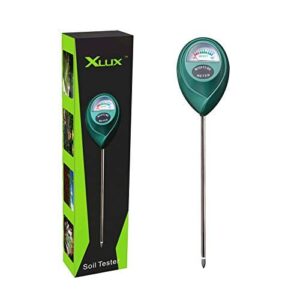 View On Amazon
View On Amazon Picture waking up in spring to find your sprinkler system sighing and sputtering instead of bringing your garden to life—winter’s chill can do more damage than you might think. Protect your irrigation system
- Freeze Damage Prevention
- System Blowout Methods
- Insulation Techniques
- Professional Winterization Services
Ignoring Crop Rotation for Next Season
Skipping crop rotation is like planting seeds in yesterday’s problems—the soil remembers what you grew, and next season’s harvest pays the price. Planning ahead keeps your garden healthy by preventing nutrient depletion and breaking pest cycles.
Thoughtful rotation benefits your soil health while improving pest control and nutrient management naturally.
| Plant Family | Avoid Following With | Good Rotation Choice |
|---|---|---|
| Nightshades (tomatoes, peppers) | Nightshades | Legumes (beans, peas) |
| Brassicas (cabbage, broccoli) | Brassicas | Root vegetables |
| Legumes | Heavy feeders | Leafy greens |
| Cucurbits (squash, cucumbers) | Cucurbits | Alliums (onions, garlic) |
| Root crops | Root crops | Nightshades |
Not Protecting Plants From Wildlife and Weather
Even the best rotation plan falls short if hungry deer or harsh winds get to your plants first. Wildlife deterrents and weather protection tactics work together to safeguard your garden through unpredictable fall conditions.
Simple steps strengthen your plant hardiness and frost preparation:
- Layer mulch around root zones to buffer against the freeze-thaw cycle
- Install garden covers or burlap wraps before storms arrive
- Use fencing or netting to keep wildlife away from vulnerable plants
A few key moves will boost your plant hardiness and frost preparation:
Frequently Asked Questions (FAQs)
What not to plant in the fall?
Why plant something destined to fail? Tender perennials, tropical plants, and frost-sensitive vegetables won’t survive fall’s dropping temperatures. Summer annuals and invasive species also spell trouble.
Focus your energy on planting bulbs and cold-hardy seeds instead.
What is the gardening 3 year rule?
The gardening 3-year rule states: “First year they sleep, second year they creep, third year they leap.” This principle explains plant establishment and root development timing.
Your perennials need patience—they’re building underground strength before delivering impressive growth, which affects long-term planning and crop rotation decisions.
What gardening should be done in the fall?
Fall gardening sets you up for spring success. Plant spring bulbs, divide perennials, add compost to enrich soil, mulch beds for winter protection, and water trees deeply before frost.
These seasonal garden tasks and soil preparation tips guarantee healthier plants while avoiding gardening mistakes that compromise winter hardiness.
What is the rule of 3 in gardening?
You’ll hear designers talk about planting in odd numbers—groups of three, five, or seven create visual balance and feel more natural than pairs. This rule application brings garden harmony through asymmetry, avoiding common gardening mistakes while preparing plants for winter displays.
Practical examples include clustering three hostas or five mums for stronger impact in your garden design.
Can I plant trees in fall?
Yes, you can fall for tree planting! Autumn is actually ideal for root establishment before winter.
Choose hardy trees, water deeply weekly, and mulch for winter protection—roots grow while branches rest.
When should I fertilize fall gardens?
Apply fertilizer to your fall garden in early to mid-September, ideally after soil testing reveals specific nutrient needs.
Choose slow-release organic options that match your plants’ requirements, avoiding over-fertilization that weakens cold hardiness.
How do I prepare roses for winter?
Preparing your roses starts with pruning diseased plants and damaged canes in late fall. Stop watering two weeks before frost to harden them off.
Mound mulch eight inches high around the base for winter protection, covering the graft union. This prevents freeze damage and disease prevention.
Should I water plants before frost?
Don’t let your garden freeze up on you—watering before frost is essential. You should definitely water your plants before a hard freeze arrives.
Moist soil retains heat better than dry soil, protecting roots during the freeze-thaw cycle and preventing damage that threatens winter hardiness and spring recovery.
Can I move perennials in autumn?
Yes, you can transplant perennials in fall—it’s actually ideal timing. Autumn perennial relocation works best because cooler temperatures reduce root system disturbance stress.
Just guarantee proper post-transplant care: water deeply, mulch generously, and consider species-specific needs before cutting back perennials.
Should I fertilize my lawn in fall?
How frequently should fall fertilization fortify your lawn? Absolutely—applying a balanced fertilizer in fall strengthens roots before winter.
Test your soil first to select the right type, then apply 6-8 weeks before frost. This timing maximizes nutrient absorption while minimizing weed growth and environmental runoff.
Conclusion
Every seasoned gardener has learned these lessons the hard way—you’re just gaining an edge. By sidestepping these common fall gardening mistakes to avoid, you’re giving your plants the strongest foundation for winter survival and spring comeback.
Deep watering before frost, timely cleanup, and proper mulching aren’t complicated moves, but they make all the difference. Your garden will thank you when it wakes up healthier and more resilient next season.
Look, every gardener picks up these lessons eventually—usually after a few winters go sideways. You’re just skipping the trial-and-error phase.
When you avoid these fall mistakes, you’re setting your plants up to actually survive the cold and bounce back stronger come spring.
- https://oldworldgardenfarms.com/2022/10/20/fall-garden-mistakes/
- https://www.dammannsgardenco.com/blog/9-common-late-season-gardening-mistakes
- https://wayne.ces.ncsu.edu/2025/08/time-to-plant-a-fall-vegetable-garden/
- https://go.redirectingat.com/?id=92X1623321&xcust=homesandgardens_us_1135633014208305538&xs=1&url=https%3A%2F%2Firrigreen.com%2Fpages%2Fmission%3Fsrsltid%3DAfmBOoqOxnmzOLxoXPRetkKo6M52kXUPXIi85jMiQqJ6cIs591EtKnu3&sref=https%3A%2F%2Fwww.homesandgardens.com%2Fgardens%2Ffall-gardening-mistakes
- https://www.linkedin.com/in/chris-rigby-bb20329

